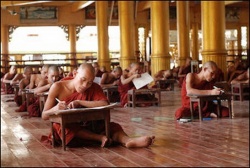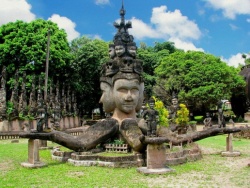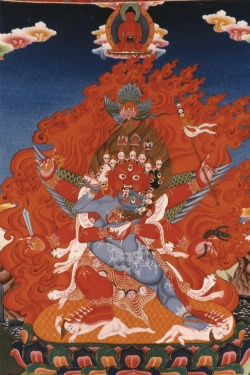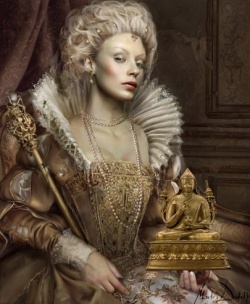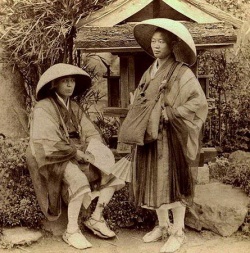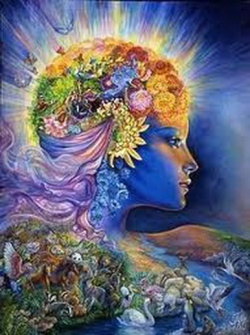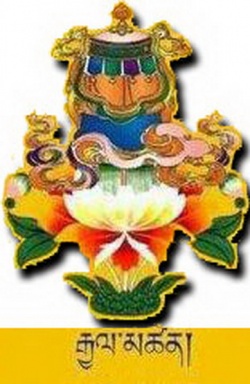Difference between revisions of "A Biographical ...པདྨ་འབྱུང་གནས། Padmasambhava"
| (2 intermediate revisions by the same user not shown) | |||
| Line 1: | Line 1: | ||
| + | <nomobile>{{DisplayImages|2401|378|4577|2081|1346|1220|3522}}</nomobile> | ||
| Line 4: | Line 5: | ||
| + | Despite the many layers of legend that have accreted around [[Padmasambhava]], [[scholars]] generally agree that a renowned [[Indian]] [[tantric master]] by that [[name]] did visit and teach [[in Tibet]] in the late eighth century. | ||
| − | + | Our earliest {{Wiki|evidence}} for his [[activities]] comes from several tenth-century [[manuscripts]] found in the so-called "library [[cave]]" of [[Dunhuang]]. Pelliot tibétain 44 is a small booklet devoted to the [[tantric deity]] [[Vajrakīla]]. It describes the [[master's]] time in [[India]] and [[Nepal]] before his trip to [[Tibet]]. | |
| − | |||
| − | + | According to this account, he [[gathered]] the texts and performed the [[rites]] for The Hundred Thousand [Verse] [[Tantra]] of [[Vajrakīla]] (phur bu'i 'bum sde) at the [[Asura cave]] in [[Yanglesho]] ([[yang le shod]]), [[Nepal]]. | |
| − | + | During this same period, he is also said to have tamed four troublesome Se (bse) [[goddesses]] and bestowed upon them new [[Buddhist]] names. On gaining [[accomplishment]] in the practices of [[Vajrakīla]], the [[master]] then performed a series of [[miracles]], [[including]] the [[magical]] diversion of a {{Wiki|stream}} for irrigation purposes. | |
| + | Pelliot tibétain 307 is a scroll containing several texts on the seven mothers (ma [[bdun]]), a set of seven [[goddesses]] native to the [[Tibetan]] landscape. The framing {{Wiki|narrative}} for the [[rites]] found therein tells how, under the [[buddhas]]' earlier subjugation of [[Rudra]], [[Padmasambhava]] and the [[Tibetan]] | ||
| − | + | [[Lang Pelgyi Sengge]] ([[rlang dpal gyis seng ge]], 8th century) tamed the seven mothers and bestowed on them oaths and new names as [[protectors]] of [[Secret Mantra]]. Now led by [[Dorje Kundrakma]] ([[rdo rje kun grags ma]]), formerly named [[Kongla Demo]] ([[rkong la de mo]]), the [[Buddhist]] mothers are finally supplicated for their assistance. | |
| − | |||
| − | Another text that many [[scholars]] have suggested may have been written by the historical [[Padmasambhava]] is the [[Garland of Views]]: A [[Pith Instruction]] ([[man ngag | + | Also possibly significant is the [[Dunhuang]] {{Wiki|manuscript}} IOL Tib J 644, which contains a text on the [[nine vehicles]] ([[theg pa dgu]]). In its [[discussion]] of the [[Kriyā tantras]], there appear many {{Wiki|narrative}} threads that are found woven into certain later biographical accounts of [[Padmasambhava's]] [[activities]]. Thus, for |
| + | |||
| + | example, the {{Wiki|ideal}} [[Kriyā-tantra]] [[practitioner]] [[meditates]] in an [[Asura cave]], attains a [[vision]] of his [[deity]], reveals a new {{Wiki|stream}}, and so on. Such details suggest that the {{Wiki|biographies}} of this [[master]] were woven from historical fact as well as [[traditional]] {{Wiki|memes}} and {{Wiki|narrative}} themes. | ||
| + | |||
| + | |||
| + | |||
| + | In addition to the above-mentioned biographical snippets, the [[Dunhuang]] archive also contains a lengthy commentary titled the [[Lotus Garland Synopsis]] ([[padma 'phreng gi don bsdus]] pa), a commentary on the [[Mahāyoga tantra]] known as the [[Noose of Methods]] ([[thabs kyi zhags pa]]). | ||
| + | |||
| + | |||
| + | Both the commentary and its [[tantra]] are preserved in later [[Wikipedia:canonical|canonical]] collections, but only in the [[Dunhuang]] version are their connections to [[Padmasambhava]] so clearly spelled out; only there do several interlinear notes appear to suggest that the commentary was written by none other than [[Padmasambhava]]. Some | ||
| + | |||
| + | [[scholars]], it should be observed, have proposed that these notes might be interpreted to mean that the eighth-century [[master]] wrote the [[tantra]] itself, but a more straightforward [[interpretation]] would suggest the commentary. | ||
| + | |||
| + | Another text that many [[scholars]] have suggested may have been written by the historical [[Padmasambhava]] is the [[Garland of Views]]: A [[Pith Instruction]] ([[man ngag lta ba'i 'phreng ba]]), and still others are also possible, such as his supposed commentary to the Vajravidāraṇā-dhāraṇī (Toh. 2679). | ||
Taken together, these writings provide some [[sense]] of the historical [[master's]] eighth-century interests. We can at least say that he appears to have been deeply involved in the [[Buddhist tantras]], [[including]] those of the [[Mahāyoga]] class and in particular, perhaps, those relating to the [[deity]] [[Vajrakīla]]. | Taken together, these writings provide some [[sense]] of the historical [[master's]] eighth-century interests. We can at least say that he appears to have been deeply involved in the [[Buddhist tantras]], [[including]] those of the [[Mahāyoga]] class and in particular, perhaps, those relating to the [[deity]] [[Vajrakīla]]. | ||
| − | During the later dissemination of [[Buddhism in Tibet]] ([[phyi dar]]), [[Tibetan literature]] exhibits an ever-increasing [[interest]] in [[Padmasambhava]]. The Testament of Wa/Ba (dba'/sba bzhed), parts of which may date from the tenth or eleventh centuries | + | During the later dissemination of [[Buddhism in Tibet]] ([[phyi dar]]), [[Tibetan literature]] exhibits an ever-increasing [[interest]] in [[Padmasambhava]]. [[The Testament of Wa]]/[[Ba (dba']]/[[sba bzhed]]), parts of which may date from |
| + | |||
| + | the tenth or eleventh centuries is an early history of the {{Wiki|imperial}} period that includes a brief {{Wiki|narrative}} of the eighth-century [[master's]] visit to [[Tibet]]. Here we see many of the details that would | ||
| + | |||
| + | become so well known in later years: The [[monk]] [[Śāntarakṣita]] suggests to [[King Tri Songdetsen]] ([[khri srong lde brtsan]], c. 742-800) that he invite [[Padmasambhava]] to assist with the founding of [[Samye]] ([[bsam yas]]), [[Tibet's]] first [[Buddhist monastery]]. | ||
| + | |||
| + | |||
| + | On his arrival, the [[master]] offers a series of {{Wiki|prophecies}} and tames [[Tibet's]] [[local spirits]] who are resisting the introduction of [[Buddhism]]. [[The Testament of Wa]] also has the [[master]] overseeing several irrigation projects in the area around [[Samye]]. Such details have led some [[scholars]] to suggest that irrigation, and the | ||
| + | |||
| + | [[spirit]] taming that would have entailed, may have been an area of particular expertise for the [[master]]. In the end, however, these same irrigation [[activities]] run him afoul of the [[king]] and his ministers, and he is soon forced to leave the country. On his way out, [[Padmasambhava]] pauses at the border to make a final {{Wiki|prophecy}}, | ||
| − | + | predicting trouble for [[Tibet]] and its [[Buddhists]] because of his not having been able to complete his [[activities]]. | |
| Line 31: | Line 54: | ||
Many of these themes are picked up and developed in subsequent {{Wiki|biographies}}. Particularly influential was the [[Copper Palace]] ([[zangs gling ma]]), a [[treasure revelation]] discovered by [[Nyangrel Nyima Ozer]] ([[nyang ral nyi ma 'od zer]], 1124-1192). This was the first complete {{Wiki|hagiographical}} account of [[Padmasambhava's]] [[life]]. | Many of these themes are picked up and developed in subsequent {{Wiki|biographies}}. Particularly influential was the [[Copper Palace]] ([[zangs gling ma]]), a [[treasure revelation]] discovered by [[Nyangrel Nyima Ozer]] ([[nyang ral nyi ma 'od zer]], 1124-1192). This was the first complete {{Wiki|hagiographical}} account of [[Padmasambhava's]] [[life]]. | ||
| − | Many of its [[Wikipedia:narrative|narratives]] were also incorporated into [[Nyangrel's]] history, the [[Flower Nectar]]: The [[Essence of Honey]] ([[chos 'byung | + | Many of its [[Wikipedia:narrative|narratives]] were also incorporated into [[Nyangrel's]] history, the [[Flower Nectar]]: The [[Essence of Honey]] ([[chos 'byung me tog snying po sbrag rtsi'i bcud]]) and then further expanded in the famous [[Pema Chronicles]] ([[padma bka'thang]]), another revealed {{Wiki|hagiography}} discovered by the fourteenth-century [[treasure revealer]] [[Orgyen Lingpa]] ([[o rgyan gling pa]], b. 1323). By the time of this figure, the {{Wiki|legends}} of [[Padmasambhava]] were well established [[in Tibet]], his role within the [[Nyingma tradition's]] [[treasure tradition]] predominant. |
According to these {{Wiki|legends}}, [[Padmasambhava]] was born amidst miraculous circumstances and grew up a {{Wiki|prince}} in [[Oḍḍiyāna]], in {{Wiki|northwestern India}}. As a youth, the {{Wiki|prince}} turns to [[tantric practice]], and before long, the local [[people]] force his father, the [[king]], to send him into exile. | According to these {{Wiki|legends}}, [[Padmasambhava]] was born amidst miraculous circumstances and grew up a {{Wiki|prince}} in [[Oḍḍiyāna]], in {{Wiki|northwestern India}}. As a youth, the {{Wiki|prince}} turns to [[tantric practice]], and before long, the local [[people]] force his father, the [[king]], to send him into exile. | ||
| − | [[Padmasambhava]] then travels around [[India]], receiving teachings and practicing in [[sacred]] [[charnel grounds]]. Eventually he arrives in [[Yanglesho]], where he gathers the texts of [[Vajrakīla]], ends a drought by defeating some troublesome [[local spirits]], and gains [[realization]]. While in [[Nepal]], he receives [[King]] Tri Songdetsen's invitation and proceeds to [[Tibet]], where he battles a now much-expanded series of local [[Tibetan]] [[spirits]], helps to establish [[Samye]], and leaves while pronouncing many ominous {{Wiki|prophecies}} regarding the {{Wiki|future}} of [[Buddhism in Tibet]]. | + | [[Padmasambhava]] then travels around [[India]], receiving teachings and practicing in [[sacred]] [[charnel grounds]]. Eventually, he arrives in [[Yanglesho]], where he gathers the texts of [[Vajrakīla]], ends a drought by defeating some troublesome [[local spirits]], and gains [[realization]]. While in [[Nepal]], he receives [[King]] Tri Songdetsen's |
| + | |||
| + | invitation and proceeds to [[Tibet]], where he battles a now much-expanded series of local [[Tibetan]] [[spirits]], helps to establish [[Samye]], and leaves while pronouncing many ominous {{Wiki|prophecies}} regarding the {{Wiki|future}} of [[Buddhism in Tibet]]. | ||
| − | Of particular note in these later accounts are the [[master's]] involvements with the {{Wiki|princess}} [[Yeshe Tsogyel]] ([[ye shes mtsho rgyal]]), as well as his [[concealment]] of various [[treasures]] for discovery by later [[reincarnations]] of his [[twenty-five principal disciples]] ([[rje 'bangs nyer lnga]]). | + | Of particular note in these later accounts are the [[master's]] involvements with the {{Wiki|princess}} [[Yeshe Tsogyel]] ([[ye shes mtsho rgyal]]), as well as his [[concealment]] of various [[treasures]] for discovery by later [[reincarnations]] of his [[twenty-five principal disciples]] ([[rje'bangs nyer lnga]]). |
| − | Scores of [[Padmasambhava]] {{Wiki|biographies}} have been produced as [[treasure texts]], each adding new material to his rich biographical [[tradition]]. And because place is so often central to the [[revelation]] of [[treasure]], countless [[religious]] sites that the eighth-century [[master]] is believed to have visited are scattered across today’s [[Tibetan Plateau]]. | + | Scores of [[Padmasambhava]] {{Wiki|biographies}} have been produced as [[treasure texts]], each adding new material to his rich biographical [[tradition]]. And because the place is so often central to the [[revelation]] of [[treasure]], countless [[religious]] sites that the eighth-century [[master]] is believed to have visited are scattered across today’s [[Tibetan Plateau]]. |
| + | |||
| − | In the later [[treasure traditions]], e.g. that of [[Guru Chowang]] ([[gu ru chos dbang]], 1212-1270), [[Padmasambhava]] is depicted as having eight [[manifestations]] ([[gu ru mtshan brgyad]]), each of which reflect a different aspect of the [[master's]] miraculous [[activities]]: Shākya [[Sengge]] ([[shAkya seng | + | In the later [[treasure traditions]], e.g. that of [[Guru Chowang]] ([[gu ru chos dbang]], 1212-1270), [[Padmasambhava]] is depicted as having eight [[manifestations]] ([[gu ru mtshan brgyad]]), each of which reflect a different aspect of the [[master's]] miraculous [[activities]]: Shākya [[Sengge]] ([[shAkya seng get]]), |
| − | Through these means, [[Padmasambhava]] has become central to the [[treasure traditions]] of the [[Nyingma School]]. This is quite unlike the [[traditions]] witnessed | + | [[Padmasambhava]], [[Nyima Ozer]] ([[nyi ma 'od zer]]), [[Sengge Dradrok]] ([[seng ge sgra sgrog]]), [[Dorje Drolo]] ([[rdo rje gro lod]]), [[Tsokye Dorje]] ([[mtsho skyes rdo rje]]), [[Pem Gyelpo]] ([[padma rgyal po]]), and |
| + | |||
| + | [[Loden Chokse]] ([[blo ldan mchog sras]]). These eight [[manifestations]] are frequently depicted in [[art]] both individually and as a group, and some, such as [[Dorje Drolo]], have developed into popular [[deities]] with liturgical [[traditions]] of their [[own]]. | ||
| + | |||
| + | |||
| + | Through these means, [[Padmasambhava]] has become central to the [[treasure traditions]] of the [[Nyingma School]]. This is quite unlike the [[traditions]] witnessed before the fourteenth century, when [[Vimalamitra]] and other [[masters]] often served as the original [[teachers]] of revealed [[treasure]], and, of course, within the | ||
| + | |||
| + | [[treasures]] of the [[Bon religion]]. Whereas early [[Bon texts]] tend to depict the [[master]] negatively, as an enemy of their [[traditions]], later writings of the [[New Bon]] ([[bon gsar]]) sometimes claim him as one of their | ||
| + | |||
| + | [[own]], adding [[Bon]] interpretations of his [[birth]], episodes in [[Zhangzhung]], and so on to their renditions of the [[master’s]] {{Wiki|biography}}. | ||
Jacob Dalton is Assistant [[Professor]] of [[Tibetan Buddhist]] Studies at the {{Wiki|University of California, Berkeley}}. | Jacob Dalton is Assistant [[Professor]] of [[Tibetan Buddhist]] Studies at the {{Wiki|University of California, Berkeley}}. | ||
| Line 55: | Line 90: | ||
{{BigTibetan|[[པདྨ་འབྱུང་གནས།]]}} | {{BigTibetan|[[པདྨ་འབྱུང་གནས།]]}} | ||
| − | [[Padmasambhava]] | + | |
| + | [[Padmasambhava]]== | ||
| − | [[Tradition]] | + | ==[[Tradition]]== |
| − | + | ==[[Nyingma]]== | |
| − | {{Wiki|Geography}} | + | =={{Wiki|Geography}}== |
| − | [[Traditional]] [[Tibetan]] Divisions | + | ==[[Traditional]] [[Tibetan]] Divisions== |
| − | Historical Period | + | ==Historical Period== |
| Line 73: | Line 109: | ||
| − | Institution | + | ==Institution== |
| − | [[Samye]] | + | ==[[Samye]]== |
[[Māratika]] | [[Māratika]] | ||
| − | [[Name]] variants: [[Guru Rinpoche]]; [[ | + | [[Name]] variants: [[Guru Rinpoche]]; [[Padmasambhava]] |
| + | |||
| + | |||
| + | ==[[Teachers]]== | ||
| + | |||
| + | |||
| + | [[gsal ba'i rgyan]] | ||
| + | |||
| + | [[bde ba gsal mdzad]] | ||
| − | |||
| − | |||
| − | |||
[[dpal gyi seng ge]] | [[dpal gyi seng ge]] | ||
| − | Students | + | ==Students== |
| − | Lang Pelgyi Senggeb.early 8th cent. - d.late 8th cent. | + | [[Lang Pelgyi Senggeb]].early 8th cent. - d.late 8th cent. |
[[Name]] variants: [[Pelgyi Sengge]] | [[Name]] variants: [[Pelgyi Sengge]] | ||
| − | [[bai ro tsa | + | [[bai ro tsa an]] |
| + | |||
[[Nubchen Sanggye Yesheb]].844? | [[Nubchen Sanggye Yesheb]].844? | ||
[[Name]] variants: [[Nub Sanggye Yeshe]]; [[Sanggye Yeshe]] | [[Name]] variants: [[Nub Sanggye Yeshe]]; [[Sanggye Yeshe]] | ||
| + | |||
[[g.yu sgra snying po]] | [[g.yu sgra snying po]] | ||
| + | |||
[[Gyelwa]] Chokyang8th cent. | [[Gyelwa]] Chokyang8th cent. | ||
| + | |||
[[Name]] variants: [[Ngenlam Gyelwa Choyang]] | [[Name]] variants: [[Ngenlam Gyelwa Choyang]] | ||
| + | |||
Ma Rinchen Chokb.early 8th cent. - d.late 8th cent. | Ma Rinchen Chokb.early 8th cent. - d.late 8th cent. | ||
| − | [[Name]] variants: Matok Rinchen | + | |
| + | |||
| + | [[Name]] variants: [[Matok Rinchen]] | ||
| + | |||
[[Sokpo Pelgyi Yeshe]] 8th cent. | [[Sokpo Pelgyi Yeshe]] 8th cent. | ||
[[Name]] variants: Sokpo Lhapel | [[Name]] variants: Sokpo Lhapel | ||
| + | |||
[[Nyak]] [[Jñānakumara]].early 8th cent. - d.late 8th cent. | [[Nyak]] [[Jñānakumara]].early 8th cent. - d.late 8th cent. | ||
| Line 116: | Line 166: | ||
[[Name]] variants: [[Nyak Jnyanakumara]]; [[Nyak Yeshe Zhonnu]] | [[Name]] variants: [[Nyak Jnyanakumara]]; [[Nyak Yeshe Zhonnu]] | ||
[[Yeshe Tsogyel]] 8th cent. | [[Yeshe Tsogyel]] 8th cent. | ||
| + | |||
[[Name]] variants: [[Khandro]] [[Yeshe Tsogyel]] | [[Name]] variants: [[Khandro]] [[Yeshe Tsogyel]] | ||
| + | |||
[[Tri Songdetsen]] b.742 - d.796 | [[Tri Songdetsen]] b.742 - d.796 | ||
| + | |||
| + | |||
[[Odren Pelgyi Wangchuk]] 8th cent. | [[Odren Pelgyi Wangchuk]] 8th cent. | ||
| + | |||
[[Name]] variants: [[Pelgyi Wangchuk]] | [[Name]] variants: [[Pelgyi Wangchuk]] | ||
| − | [[Khyeuchung Lotsāwa]] b.early 8th cent. - d.late 8th cent. | + | |
| + | [[Khyeuchung Lotsāwa]] b.early 8th cent. - d.late 8th cent | ||
| + | . | ||
[[Gyelwai Lodrob]].early 9th cent. - d.late 9th cent. | [[Gyelwai Lodrob]].early 9th cent. - d.late 9th cent. | ||
| + | |||
[[Name]] variants: [[Gonpo]] | [[Name]] variants: [[Gonpo]] | ||
| + | |||
[[Nanam Yeshe]] Deb.mid 8th cent. - d.early 9th cent. | [[Nanam Yeshe]] Deb.mid 8th cent. - d.early 9th cent. | ||
| − | [[Name]] variants: [[Nanam Zhang]]; [[Nanam Zhang Yeshe De]]; [[Yeshe De]]; | + | [[Name]] variants: [[Nanam Zhang]]; [[Nanam Zhang Yeshe De]]; [[Yeshe De]]; [[Zhang Bande Yeshe De]]; [[Zhuchen Lotsāwa]] |
| + | |||
[[Namkhai Nyingpo]] 8th cent. | [[Namkhai Nyingpo]] 8th cent. | ||
[[Name]] variants: [[Nub Namkhai Nyingpo]] | [[Name]] variants: [[Nub Namkhai Nyingpo]] | ||
| + | |||
[[Kharchen]] Pelgyi Wangchuk8th cent. | [[Kharchen]] Pelgyi Wangchuk8th cent. | ||
[[Name]] variants: [[Pelgyi Wangchuk]] | [[Name]] variants: [[Pelgyi Wangchuk]] | ||
| + | |||
| + | |||
Yeshe Yangd.862 | Yeshe Yangd.862 | ||
| − | [[Name]] variants: | + | [[Name]] variants: [[Atsar Yeshe Yang]]; [[Ba Yeshe Yang]]; [[Yeshe Wangpo]] |
| − | |||
| − | |||
| − | [[Name]] variants: Peltsek | + | [[Denma Tsemangb]].mid 8th cent. - d.early 9th cent. |
| − | Pelgyi Senggeb.8th cent. - d.9th cent. | + | |
| + | [[Kawa Peltsekb]].early 8th cent. - d.late 8th cent. | ||
| + | |||
| + | |||
| + | |||
| + | [[Name]] variants: [[Peltsek]] | ||
| + | |||
| + | [[Pelgyi Senggeb]].8th cent. - d.9th cent. | ||
| + | |||
| + | |||
| + | [[Name]] variants: [[Shubu Pelgyi Sengge]]; Tridring Kongtsan | ||
| + | |||
| + | [[Lhalung Pelgyi Dorje]] 8th cent. | ||
| − | |||
| − | |||
[[Name]] variants: [[Pelgyi Dorje]] | [[Name]] variants: [[Pelgyi Dorje]] | ||
| − | [[Langdro | + | |
| + | [[Langdro Konchok Jungneb]].early 8th cent. - d.late 8th cent. | ||
| + | |||
[[Name]] variants: [[Konchok Jungne]] | [[Name]] variants: [[Konchok Jungne]] | ||
| − | [[Lasum | + | |
| + | [[Lasum Gyelwa Jangchubb]].early 8th cent. - d.late 8th cent. | ||
[[Name]] variants: [[Gyelwa Jangchub]] | [[Name]] variants: [[Gyelwa Jangchub]] | ||
| + | |||
| + | |||
| + | |||
{{R}} | {{R}} | ||
| + | [[Category:Buddhist Terms]] | ||
http://treasuryoflives.org/biographies/view/Padmasambhava/7442 | http://treasuryoflives.org/biographies/view/Padmasambhava/7442 | ||
| − | |||
[[Category:Padmasambhava]] | [[Category:Padmasambhava]] | ||
Latest revision as of 08:43, 9 March 2024
Despite the many layers of legend that have accreted around Padmasambhava, scholars generally agree that a renowned Indian tantric master by that name did visit and teach in Tibet in the late eighth century.
Our earliest evidence for his activities comes from several tenth-century manuscripts found in the so-called "library cave" of Dunhuang. Pelliot tibétain 44 is a small booklet devoted to the tantric deity Vajrakīla. It describes the master's time in India and Nepal before his trip to Tibet.
According to this account, he gathered the texts and performed the rites for The Hundred Thousand [Verse] Tantra of Vajrakīla (phur bu'i 'bum sde) at the Asura cave in Yanglesho (yang le shod), Nepal.
During this same period, he is also said to have tamed four troublesome Se (bse) goddesses and bestowed upon them new Buddhist names. On gaining accomplishment in the practices of Vajrakīla, the master then performed a series of miracles, including the magical diversion of a stream for irrigation purposes.
Pelliot tibétain 307 is a scroll containing several texts on the seven mothers (ma bdun), a set of seven goddesses native to the Tibetan landscape. The framing narrative for the rites found therein tells how, under the buddhas' earlier subjugation of Rudra, Padmasambhava and the Tibetan
Lang Pelgyi Sengge (rlang dpal gyis seng ge, 8th century) tamed the seven mothers and bestowed on them oaths and new names as protectors of Secret Mantra. Now led by Dorje Kundrakma (rdo rje kun grags ma), formerly named Kongla Demo (rkong la de mo), the Buddhist mothers are finally supplicated for their assistance.
Also possibly significant is the Dunhuang manuscript IOL Tib J 644, which contains a text on the nine vehicles (theg pa dgu). In its discussion of the Kriyā tantras, there appear many narrative threads that are found woven into certain later biographical accounts of Padmasambhava's activities. Thus, for
example, the ideal Kriyā-tantra practitioner meditates in an Asura cave, attains a vision of his deity, reveals a new stream, and so on. Such details suggest that the biographies of this master were woven from historical fact as well as traditional memes and narrative themes.
In addition to the above-mentioned biographical snippets, the Dunhuang archive also contains a lengthy commentary titled the Lotus Garland Synopsis (padma 'phreng gi don bsdus pa), a commentary on the Mahāyoga tantra known as the Noose of Methods (thabs kyi zhags pa).
Both the commentary and its tantra are preserved in later canonical collections, but only in the Dunhuang version are their connections to Padmasambhava so clearly spelled out; only there do several interlinear notes appear to suggest that the commentary was written by none other than Padmasambhava. Some
scholars, it should be observed, have proposed that these notes might be interpreted to mean that the eighth-century master wrote the tantra itself, but a more straightforward interpretation would suggest the commentary.
Another text that many scholars have suggested may have been written by the historical Padmasambhava is the Garland of Views: A Pith Instruction (man ngag lta ba'i 'phreng ba), and still others are also possible, such as his supposed commentary to the Vajravidāraṇā-dhāraṇī (Toh. 2679).
Taken together, these writings provide some sense of the historical master's eighth-century interests. We can at least say that he appears to have been deeply involved in the Buddhist tantras, including those of the Mahāyoga class and in particular, perhaps, those relating to the deity Vajrakīla.
During the later dissemination of Buddhism in Tibet (phyi dar), Tibetan literature exhibits an ever-increasing interest in Padmasambhava. The Testament of Wa/Ba (dba'/sba bzhed), parts of which may date from
the tenth or eleventh centuries is an early history of the imperial period that includes a brief narrative of the eighth-century master's visit to Tibet. Here we see many of the details that would
become so well known in later years: The monk Śāntarakṣita suggests to King Tri Songdetsen (khri srong lde brtsan, c. 742-800) that he invite Padmasambhava to assist with the founding of Samye (bsam yas), Tibet's first Buddhist monastery.
On his arrival, the master offers a series of prophecies and tames Tibet's local spirits who are resisting the introduction of Buddhism. The Testament of Wa also has the master overseeing several irrigation projects in the area around Samye. Such details have led some scholars to suggest that irrigation, and the
spirit taming that would have entailed, may have been an area of particular expertise for the master. In the end, however, these same irrigation activities run him afoul of the king and his ministers, and he is soon forced to leave the country. On his way out, Padmasambhava pauses at the border to make a final prophecy,
predicting trouble for Tibet and its Buddhists because of his not having been able to complete his activities.
Many of these themes are picked up and developed in subsequent biographies. Particularly influential was the Copper Palace (zangs gling ma), a treasure revelation discovered by Nyangrel Nyima Ozer (nyang ral nyi ma 'od zer, 1124-1192). This was the first complete hagiographical account of Padmasambhava's life.
Many of its narratives were also incorporated into Nyangrel's history, the Flower Nectar: The Essence of Honey (chos 'byung me tog snying po sbrag rtsi'i bcud) and then further expanded in the famous Pema Chronicles (padma bka'thang), another revealed hagiography discovered by the fourteenth-century treasure revealer Orgyen Lingpa (o rgyan gling pa, b. 1323). By the time of this figure, the legends of Padmasambhava were well established in Tibet, his role within the Nyingma tradition's treasure tradition predominant.
According to these legends, Padmasambhava was born amidst miraculous circumstances and grew up a prince in Oḍḍiyāna, in northwestern India. As a youth, the prince turns to tantric practice, and before long, the local people force his father, the king, to send him into exile.
Padmasambhava then travels around India, receiving teachings and practicing in sacred charnel grounds. Eventually, he arrives in Yanglesho, where he gathers the texts of Vajrakīla, ends a drought by defeating some troublesome local spirits, and gains realization. While in Nepal, he receives King Tri Songdetsen's
invitation and proceeds to Tibet, where he battles a now much-expanded series of local Tibetan spirits, helps to establish Samye, and leaves while pronouncing many ominous prophecies regarding the future of Buddhism in Tibet.
Of particular note in these later accounts are the master's involvements with the princess Yeshe Tsogyel (ye shes mtsho rgyal), as well as his concealment of various treasures for discovery by later reincarnations of his twenty-five principal disciples (rje'bangs nyer lnga).
Scores of Padmasambhava biographies have been produced as treasure texts, each adding new material to his rich biographical tradition. And because the place is so often central to the revelation of treasure, countless religious sites that the eighth-century master is believed to have visited are scattered across today’s Tibetan Plateau.
In the later treasure traditions, e.g. that of Guru Chowang (gu ru chos dbang, 1212-1270), Padmasambhava is depicted as having eight manifestations (gu ru mtshan brgyad), each of which reflect a different aspect of the master's miraculous activities: Shākya Sengge (shAkya seng get),
Padmasambhava, Nyima Ozer (nyi ma 'od zer), Sengge Dradrok (seng ge sgra sgrog), Dorje Drolo (rdo rje gro lod), Tsokye Dorje (mtsho skyes rdo rje), Pem Gyelpo (padma rgyal po), and
Loden Chokse (blo ldan mchog sras). These eight manifestations are frequently depicted in art both individually and as a group, and some, such as Dorje Drolo, have developed into popular deities with liturgical traditions of their own.
Through these means, Padmasambhava has become central to the treasure traditions of the Nyingma School. This is quite unlike the traditions witnessed before the fourteenth century, when Vimalamitra and other masters often served as the original teachers of revealed treasure, and, of course, within the
treasures of the Bon religion. Whereas early Bon texts tend to depict the master negatively, as an enemy of their traditions, later writings of the New Bon (bon gsar) sometimes claim him as one of their
own, adding Bon interpretations of his birth, episodes in Zhangzhung, and so on to their renditions of the master’s biography.
Jacob Dalton is Assistant Professor of Tibetan Buddhist Studies at the University of California, Berkeley.
Published June 2014
Updated June 2015
Tradition
Nyingma
Geography
Traditional Tibetan Divisions
Historical Period
8th Century
Institution
Samye
Name variants: Guru Rinpoche; Padmasambhava
Teachers
Students
Lang Pelgyi Senggeb.early 8th cent. - d.late 8th cent.
Name variants: Pelgyi Sengge
Name variants: Nub Sanggye Yeshe; Sanggye Yeshe
Gyelwa Chokyang8th cent.
Name variants: Ngenlam Gyelwa Choyang
Ma Rinchen Chokb.early 8th cent. - d.late 8th cent.
Name variants: Matok Rinchen
Sokpo Pelgyi Yeshe 8th cent.
Name variants: Sokpo Lhapel
Nyak Jñānakumara.early 8th cent. - d.late 8th cent.
Name variants: Nyak Jnyanakumara; Nyak Yeshe Zhonnu
Yeshe Tsogyel 8th cent.
Name variants: Khandro Yeshe Tsogyel
Tri Songdetsen b.742 - d.796
Odren Pelgyi Wangchuk 8th cent.
Name variants: Pelgyi Wangchuk
Khyeuchung Lotsāwa b.early 8th cent. - d.late 8th cent . Gyelwai Lodrob.early 9th cent. - d.late 9th cent.
Nanam Yeshe Deb.mid 8th cent. - d.early 9th cent.
Name variants: Nanam Zhang; Nanam Zhang Yeshe De; Yeshe De; Zhang Bande Yeshe De; Zhuchen Lotsāwa
Namkhai Nyingpo 8th cent.
Name variants: Nub Namkhai Nyingpo
Kharchen Pelgyi Wangchuk8th cent.
Name variants: Pelgyi Wangchuk
Yeshe Yangd.862
Name variants: Atsar Yeshe Yang; Ba Yeshe Yang; Yeshe Wangpo
Denma Tsemangb.mid 8th cent. - d.early 9th cent.
Kawa Peltsekb.early 8th cent. - d.late 8th cent.
Pelgyi Senggeb.8th cent. - d.9th cent.
Name variants: Shubu Pelgyi Sengge; Tridring Kongtsan
Lhalung Pelgyi Dorje 8th cent.
Name variants: Pelgyi Dorje
Langdro Konchok Jungneb.early 8th cent. - d.late 8th cent.
Name variants: Konchok Jungne
Lasum Gyelwa Jangchubb.early 8th cent. - d.late 8th cent.
Name variants: Gyelwa Jangchub
Source
http://treasuryoflives.org/biographies/view/Padmasambhava/7442
